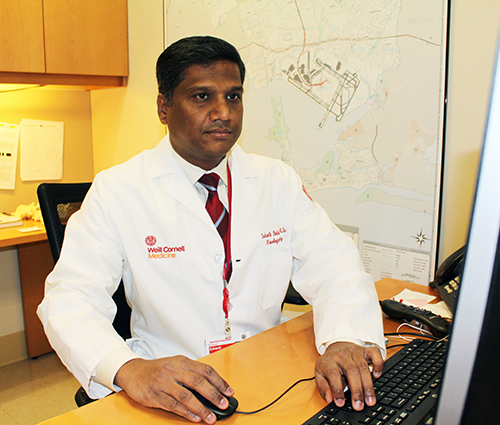
Ten years ago, as a neurointerventional fellow at Nottingham University Hospitals in the U.K., I was excited to be part of a team that was performing an innovative new procedure called venous sinus stenting (VSS). It was a minimally invasive procedure that we were using to relieve the symptoms of venous sinus stenosis in patients.
At the same time, Weill Cornell Medicine was launching a clinical trial, testing whether U.S. patients could benefit from this procedure to relieve the headaches and vision problems caused by the narrowing of the brain's draining veins. The first patient was a young woman who had been diagnosed with pseudotumor cerebri and was losing vision due to high intracranial pressure. After the venous sinus stenting, the patient recovered her vision completely and all the other symptoms of increased intracranial pressure were also resolved.
In 2014 I was excited to join Weill Cornell Medicine, where I could add my experience and expertise to the team developing the VSS procedure here. In the years since then, we at Weill Cornell Medicine have been at the forefront of venous sinus stenting treatment. We were the first group in the United States to design a clinical trial for this new treatment, and we worked with the FDA to ensure the highest quality of care and robust clinical research. We have developed ways to perform this procedure in the least invasive and safest possible way and we have expanded the indications to treat patients with a variety of problems, including pulsatile tinnitus.
Our venous sinus stenting program has been very successful, and we have now treated well over 100 patients. The majority have been treated for pseudotumor cerebri, but we have also treated patients with pulsatile tinnitus, venous sinus thrombosis, and dural arteriovenous fistula. We have treated children as young as 20 months and adults as old as 60. Our patients come from all over the United States and from overseas.
The results of this treatment speak for themselves. We have published our work in prestigious journals and presented our experience in every major national and international meeting, and we have established ourselves as one of the premier groups for this treatment with an international reputation.
All this work, however, would be meaningless without the genuine gratification we get from helping our patients. We know they trusted us with their lives, and we are grateful to them for trusting us and allowing us to perform a new and innovative treatment. I am personally indebted to them as they are testament to the benefits and safety if this treatment. (Several of them have been profiled online: See a list of success stories from patients with pulsatile tinnitus and pseudotumor cerebri.)
I am also thankful to the members of our team who work tirelessly and make all necessary arrangements for our patients: the patient coordinators, medical assistants, surgical coordinators, and advanced practice providers from my office as well as from Dr. Dinkin’s and Dr. Oliveira’s office. They are the pillars of this program and I am truly grateful for their help and dedication. I am proud to work and collaborate with them.